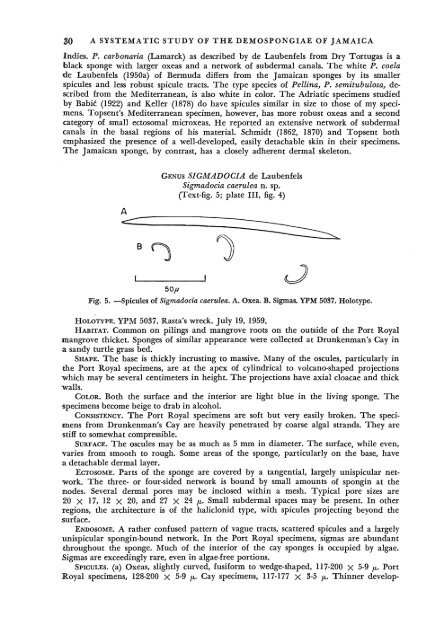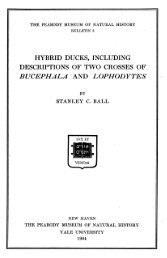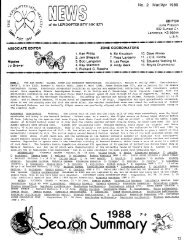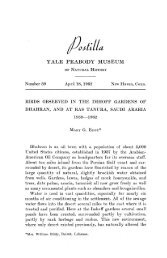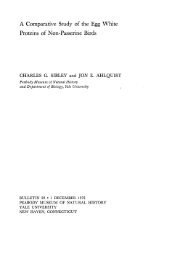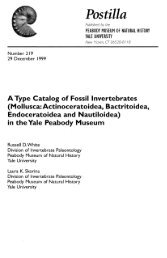Bulletin 20 - Peabody Museum of Natural History - Yale University
Bulletin 20 - Peabody Museum of Natural History - Yale University
Bulletin 20 - Peabody Museum of Natural History - Yale University
You also want an ePaper? Increase the reach of your titles
YUMPU automatically turns print PDFs into web optimized ePapers that Google loves.
30 A SYSTEMATIC STUDY OF THE DEMOSPONGIAE OF JAMAICA<br />
Indies. P. carbonaria (Lamarck) as described by de Laubenfels from Dry Tortugas is a<br />
black sponge with larger oxeas and a network <strong>of</strong> subdermal canals. The white P. coela<br />
de Laubenfels (1950a) <strong>of</strong> Bermuda differs from the Jamaican sponges by its smaller<br />
spicules and less robust spicule tracts. The type species <strong>of</strong> Pellina, P. semitubulosa, described<br />
from the Mediterranean, is also white in color. The Adriatic specimens studied<br />
by Babic (1922) and Keller (1878) do have spicules similar in size to those <strong>of</strong> my specimens.<br />
Topsent's Mediterranean specimen, however, has more robust oxeas and a second<br />
category <strong>of</strong> small ectosomal microxeas. He reported an extensive network <strong>of</strong> subdermal<br />
canals in the basal regions <strong>of</strong> his material. Schmidt (1862, 1870) and Topsent both<br />
emphasized the presence <strong>of</strong> a well-developed, easily detachable skin in their specimens.<br />
The Jamaican sponge, by contrast, has a closely adherent dermal skeleton.<br />
A<br />
GENUS SIGMADOCIA de Laubenfels<br />
Sigmadocia caerulea n. sp.<br />
(Text-fig. 5; plate III, fig. 4)<br />
50//<br />
Fig. 5. —Spicules <strong>of</strong> Sigmadocia caerulea. A. Oxea. B. Sigmas. YPM 5037. Holotype.<br />
HOLOTYPE. YPM 5037. Rasta's wreck. July 19, 1959.<br />
HABITAT. Common on pilings and mangrove roots on the outside <strong>of</strong> the Port Royal<br />
mangrove thicket. Sponges <strong>of</strong> similar appearance were collected at Drunkenman's Cay in<br />
a sandy turtle grass bed.<br />
SHAPE. The base is thickly incrusting to massive. Many <strong>of</strong> the oscules, particularly in<br />
the Port Royal specimens, are at the apex <strong>of</strong> cylindrical to volcano-shaped projections<br />
ivhich may be several centimeters in height. The projections have axial cloacae and thick<br />
-walls.<br />
COLOR. Both the surface and the interior are light blue in the living sponge. The<br />
specimens become beige to drab in alcohol.<br />
CONSISTENCY. The Port Royal specimens are s<strong>of</strong>t but very easily broken. The specimens<br />
from Drunkenman's Cay are heavily penetrated by coarse algal strands. They are<br />
stiff to somewhat compressible.<br />
SURFACE. The oscules may be as much as 5 mm in diameter. The surface, while even,<br />
varies from smooth to rough. Some areas <strong>of</strong> the sponge, particularly on the base, have<br />
a detachable dermal layer.<br />
ECTOSOME. Parts <strong>of</strong> the sponge are covered by a tangential, largely unispicular network.<br />
The three- or four-sided network is bound by small amounts <strong>of</strong> spongin at the<br />
nodes. Several dermal pores may be inclosed within a mesh. Typical pore sizes are<br />
<strong>20</strong> X 17, 12 X <strong>20</strong>, and 27 X 24 ^. Small subdermal spaces may be present. In other<br />
regions, the architecture is <strong>of</strong> the haliclonid type, with spicules projecting beyond the<br />
surface.<br />
ENDOSOME. A rather confused pattern <strong>of</strong> vague tracts, scattered spicules and a largely<br />
unispicular spongin-bound network. In the Port Royal specimens, sigmas are abundant<br />
throughout the sponge. Much <strong>of</strong> the interior <strong>of</strong> the cay sponges is occupied by algae.<br />
Sigmas are exceedingly rare, even in algae-free portions.<br />
SPICULES, (a) Oxeas, slightly curved, fusiform to wedge-shaped, 117-<strong>20</strong>0 X 5-9 p. Port<br />
Royal specimens, 128-<strong>20</strong>0 x 5-9 /A- Cay specimens, 117-177 x 3-5 /*,. Thinner develop-


